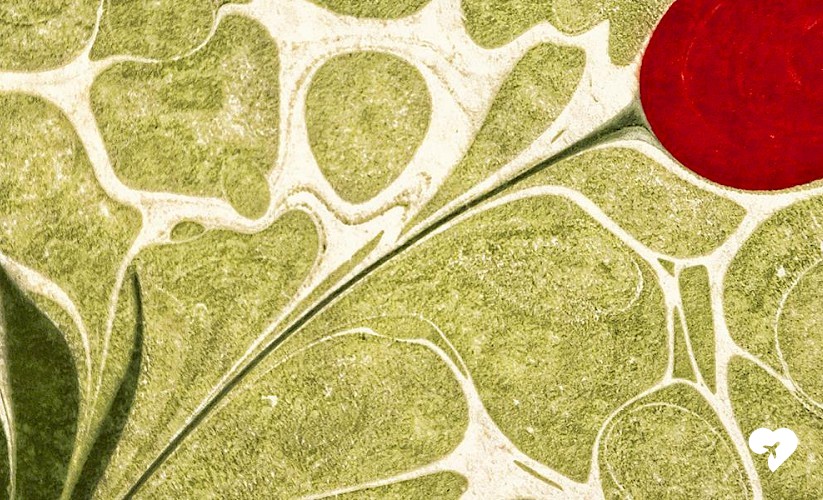Ebru is the traditional art of creating colorful patterns by sprinkling and brushing color pigments on a pan of oily water and then transforming this pattern to a special paper. It has been a traditional art of book enriching calligraphy and binding books for many centuries. In the 13th century, the first forms of Ebru emerged in Central Asia and spread to Anatolia through. During the Ottoman period, Turkish calligraphers and artists created new forms and perfected techniques.
Ebru is an art which consists of certain patterns and effects in the production, by means of colors containing a few drops of ox-gall (kind of natural acid helping the colors sprinkle on the gum) so prepared as to float upon a preparation of condensed liquid with the use of kitre (kind of herbal gum), possessing certain properties to the colors prepared for the purpose and which color floated and formed into patterns upon the surface of the liquid, are taken off by laying on a sheet of paper.
Several patterns such as gelgit, tarakli, hatip, bülbül yuvasi, çiçekli evolved over centuries. Most popularly used colors in Ebru are light green, red and yellow. The designs or motifs indicate their common pattern. The most frequently seen designs are flowers, foliage, ornamental and first quarter of the moon.
The bearers and the practitioners of the element are the Ebru artists, apprentices and people practicing Ebru, as a leisure activity or profession, who consider Ebru as an integral part of their traditional culture, identity and life style. The bearers and practitioners of the element come from all the parts of society regardless of age, gender, socio-economic backgrounds and ethnicity.
Ebru artists play a crucial role for the practice and transmission of the element. They have the responsibility of transmitting their specialized knowledge from one generation to another mainly within the master and apprentice relationship. All the materials and equipment used in Ebru are made by the artists themselves who are not only responsible for transmitting knowledge related to practice of element but also responsible for transmitting specialized knowledge related to production of materials and equipment.
Ebru is traditionally transmitted from one master to his/her apprentice through informal practical training. Basic principle of the training process of Ebru is not only the training of the technique but also the introduction of its philosophy. The apprentice usually observes and imitates the work of his/her master and assists in different stages of the application of Ebru. The training process continues with identification and production of materials and equipment. After the introduction stages of training, application process for the apprentice begins. Achieving basic skills of Ebru takes at least two years for the beginners.
In terms of transmission, the instruction in Ebru offered by the various numbers of institutions, masters, NGOs, municipalities and governorship offices through courses and workshops has increased recently, in response to the rising interest all over the country. The workshops and courses are, especially, very popular among young generation and women.

The tradition, in accordance with the individual and community aspirations, shares much optimism and improves relationships in the community. It also motivates the member of the community to be involved in common cultural activities and social meetings.
In recent years, women and youth raised interest to Ebru with the increasing number of free courses, workshops organized by local authorities and universities. The broad participation of women in Ebru serves to strengthen the role of women in society. The young practitioners by the virtue of their belonging to the element enhance identity and consciousness towards their historical and cultural heritage.
The element helps to unify people around the noteworthy art of Ebru, providing an atmosphere for friendly relations; facilitating communication and making prejudices disappear among people from different cultural backgrounds. It has contributed intercultural dialogue, reinforced social ties by encouraging conversation.
Different geographies, cultures, individuals and experiences contribute to the improvement of Ebru. Since this art brings water (symbolizing source of life), dance of colors (means of creating amazing world), and feelings of the artist together, each work of Ebru is unique art andcannot be reproduced twice. Every tiny drop of color descends into a sea of possibilities to create a masterpiece. The characteristics of Ebru allow the artistic flexibility in the choice of techniques through which can be expressed innermost feelings, thoughts and creativity. The tradition brings out human potential around the tradition of craftsmanship by ornamenting sides, inner and outer covers of special books, calligraphy, glassworks, and gifts.
For the inclusion of Ebru: Turkish Art of Marbling, İstanbul and Edirne ICH Boards prepared the required form and sent it to MoCT in 2010. Then, the Commission of Experts evaluated the nomination proposal for the element and advised to MoCT for inscription on the ICH National Inventory of Turkey. The element was included in the inventory system in 2010.
Fuat Başar, who have deep knowledge and high level skills required for professional marbling and calligraphy, proclaimed as Living Human Treasures in 2010.
"Ebru: Turkish Art Of Marbling" was registered on UNESCO's Representative List of the Intangible Cultural Heritage of Humanity on behalf of Turkey in 2014.
